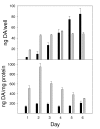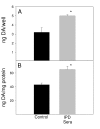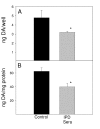Serum antibodies from Parkinson's disease patients react with neuronal membrane proteins from a mouse dopaminergic cell line and affect its dopamine expression
- PMID: 16426448
- PMCID: PMC1388197
- DOI: 10.1186/1742-2094-3-1
Serum antibodies from Parkinson's disease patients react with neuronal membrane proteins from a mouse dopaminergic cell line and affect its dopamine expression
Abstract
Evidence exists suggesting that the immune system may contribute to the severity of idiopathic Parkinson's disease (IPD). The data presented here demonstrates that antibodies in the sera of patients with IPD have increased binding affinity to dopaminergic (DA) neuronal (MN9D cell line) membrane antigens in comparison to antibodies in sera from healthy controls. In general, the degree of antibody reactivity to these antigens of the mouse MN9D cell line appears to correlate well with the disease severity of the IPD patients contributing sera, based on the total UPDRS scores. Surprisingly, the sera from IPD patients enhanced the DA content of MN9D cells differentiated with n-butyrate; the n-butyrate-differentiated MN9D cells had a greater concentration of DA (DA/mg total protein) than undifferentiated MN9D cells, especially early in culture. Although the IPD sera did not directly harm MN9D cellular viability or DA production, in the presence of the N9 microglial cell line, the amount of DA present in cultures of untreated or n-butyrate-treated MN9D cells was lowered by the IPD sera. The results suggest the involvement of antibodies in the decline of dopamine production and, thus, the potential of immune system participation in IPD.
Figures







References
LinkOut - more resources
Full Text Sources

